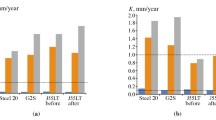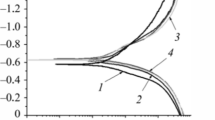Abstract
The aspects of the development of corrosion processes under the conditions of moisture condensation in the gas phase in the presence of carbon dioxide which lead to the formation of local damage at gas extraction sites are studied. A procedure for conducting the corrosion testing of steels under such conditions is developed and tested. The causes of local corrosion and the degree of the corrosive action of moisture condensation on steel in a carbon dioxide atmosphere are analyzed. It is found that condensation of a large amount of moisture on the surface of steel occurs in the case of a temperature differential, which leads to an increase in the rate of both general and local corrosion. The increased localization of corrosion processes under the conditions of moisture condensation in the presence of CO2 becomes the reason why the indicator of the depth of corrosion of steel is much higher than the total rate of corrosion. When evaluating the corrosive aggressiveness of the environments with the condensation of the aqueous phase, the indicators of the rate of corrosion associated with the depth of corrosion damage should be taken into account. It is determined on the basis of the test results that the degree of localization of corrosion under the conditions of moisture condensation is higher for the samples cut out from the welded seam when compared to the samples cut out from the parent pipe.



Similar content being viewed by others
REFERENCES
Saakiyan, L.S., Efremov, A.P., and Soboleva, I.A., Zashchita neftegazopromyslovogo oborudovaniya ot korrozii (Protection of Oil and Gas Field Equipment from Corrosion), Moscow: Nedra, 1982.
Mustafin, F.M., Kuznetsov, M.V., Vasiliev, G.G., et al., Zashchita truboprovodov ot korrozii (Corrosion Protection of Pipelines), St. Petersburg: Nedra, 2005.
Zapevalov, D.N., Vagapov, R.K., and Ibatullin, K.A., Assessment of the internal corrosion factor of Gazprom’s production facilities with a high carbon dioxide content, Nauka Tekh. Gaz. Prom-st., 2018, no. 3 (75), pp. 59–71.
Vagapov, R.K., Fedotova, A.I., Zapevalov, D.N., Strelnikova, K.O., Corrosion aggressiveness of various operational factors in hydrocarbon deposits containing carbon dioxide, Vesti Gaz. Nauki, 2019, no. 2 (39), pp. 129–135. http://vesti-gas.ru/sites/default/files/attachments/vgn-2-39-2019-129-135.pdf.
Slugin, P.P. and Polyanskii, A.V., The optimal method of combating carbon dioxide corrosion of pipelines at the Bovanenkovo oil and gas condensate field, Nauka Tekh. Gaz. Prom-st., 2018, no. 2 (74), pp. 104–109.
Moiseev, V.V., Ismagilov, I.I., and Tkesheliadze, B.T., Ensuring the safe operation of the Bovanenkovo oil and gas condensate field under the aggressive effects of CO2, Proc. 11th Int. Sci.-Tech. Conf. “Diagnostics of Equipment and Pipelines Subject to Attach of Stinkdamp-Containing Media,” Orenburg, Russia, November 15–18, 2016, Moscow: Gubkin Russ. State Univ. Oil Gas, 2017.
Koryakin, A.Yu., Dikamov, D.V., Kolinchenko, I.V., Yusupov, A.D., Zapevalov, D.N., and Vagapov, R.K., Experience of corrosion inhibitors selection to protect the objects of the second site of Achimovsky deposits of Urengoy oil and gas-condensate field from carbon acid corrosion, Oborud. Tekhnol. Neftegaz. Kompl., 2018, no. 6, pp. 48–55.
Baidin, I.I., Kharitonov, A.N., Velichkin, A.V., Il’in, A.V., and Podolyanskii, E.S., The effect of carbon dioxide in natural gas from a gas condensate deposit of the lower cretaceous deposits of the Yubileynoe oil and gas condensate field on the operation of the UKPG-NTS, Nauka Tekh. Gaz. Prom-st., 2018, no. 2 (74), pp. 23–35.
Prokopov, A.V., Kubanov, A.N., Istomin, V.A., Snezhko, D.N., Chepurnov, A.N., and Akopyan, A.K., Specific character of field treatment in respect to gases from Achim deposits, Vesti Gaz. Nauki, 2018, no. 1 (33), pp. 226–234. http://vesti-gas.ru/sites/default/files/attachments/vgn-1-33-2018-226-234.pdf.
Artemenkov, V.Yu., Koryakin, A.Yu., Shustov, I.N., Dikamov, D.V., Shishkov, E.O., and Yusupov, A.D., Organization of corrosion monitoring at the objects of the second section of the Achimov deposits of the Urengoy oil and gas condensate field, Gaz. Prom-st, 2017, no. S2, pp. 74–78.
CO 2 Corrosion Control in Oil and Gas Production, Kermani, M.V. and Smith, L.M., Eds., London: Inst. Mater., 1997.
Crolet, J.-L. and Bonis, M.R., pH measurements in CO2 aqueous solutionsunder high pressure and temperature, Corrosion, 1983, vol. 39, no. 2, pp. 39–46.
Standart Organizatsii STO Gazprom (Standard of the STO Gazprom Organization) 9.3-007-2010: Corrosion Protection. Technique for Laboratory Testing of Corrosion Inhibitors for Equipment for Production, Transportation of Processing of Reactive Gas), 2011.
Rozenfel’d, I.L. and Zhigalova, K.A., Uskorennye metody korrozionnykh ispytanii metallov (teoriya i praktika) (Accelerated Methods of Corrosion Testing of Metals (Theory and Practice)), Moscow: Metallurgiya, 1966.
GOST (State Standard) R 9.905-2007: Unified System of Corrosion and Ageing Protection. Corrosion Test Methods. General Requirements, 2009.
GOST (State Standard) 9.908-85: Unified System of Corrosion and Ageing Protection. Metals and Alloys. Methods for Determination of Corrosion and Corrosion Resistance Indices, 1987.
Standart Organizatsii STO Gazprom (Standard of the STO Gazprom Organization) 9.0-001-2018: Corrosion Protection. Basic Requirements), 2018.
GOST (State Standard) 9.502-82: Unified system of corrosion and ageing protection. Inhibitors of metals corrosion for aqueous systems. Methods of corrosion tests, 1984.
Standart Organizatsii STO Gazprom (Standard of the STO Gazprom Organization) 9.3-011-2011: Corrosion Protection. Inhibitory Corrosion Protection of Field Facilities and Pipelines. Basic Requirements, 2011.
Kuznetsov, Yu.I., Andreev, N.N., and Ibatullin,K.A., On the adjustment of pH with lower amines in carbon dioxide corrosion of steels, Prot. Met., 1999, vol. 35, no. 6, pp. 532–536.
Engineering Handbook DPVA, https://dpva.ru/Guide/ GuidePhysics/Humidity/MaximumMoistureContent-Air/ (Accessed January 28, 2020).
Asher, S.L., Sun, W., Ojifinni, R., Pacheco, J., Li, Ch., Nelson, J., and Ling, Sh., Top of the line corrosion prediction in wet gas pipelines, NACE Conf. Corrosion, 2012, art. ID C-2012-0001303.
Gunaltun, Y.M. and Larrey, D., Water-condensation rate critical in predicting, preventing TLC in wet-gas lines, Oil Gas J., 2000, vol. 98, no. 28, pp. 58–63.
Chen, Y.F., Zhang, L., Qin, H., Xu, L., and Lu, M.X., Effects of temperature on CO2 top of line corrosion of pipeline steel, NACE Conf. Corrosion, 2011, art. ID 11327.
Singer, M., Study of the localized nature of top of the line corrosion in sweet environment, Corrosion, 2017, vol. 73, no. 8, pp. 1030–1055. https://doi.org/10.5006/2222
Author information
Authors and Affiliations
Corresponding author
Additional information
Translated by E. Boltukhina
Rights and permissions
About this article
Cite this article
Vagapov, R.K., Zapevalov, D.N. & Ibatullin, K.A. The Evaluation of the Corrosion Resistance of Materials under the Conditions of Moisture Condensation in the Presence of Carbon Dioxide. Inorg. Mater. Appl. Res. 12, 1606–1614 (2021). https://doi.org/10.1134/S2075113321060289
Received:
Revised:
Accepted:
Published:
Issue Date:
DOI: https://doi.org/10.1134/S2075113321060289




